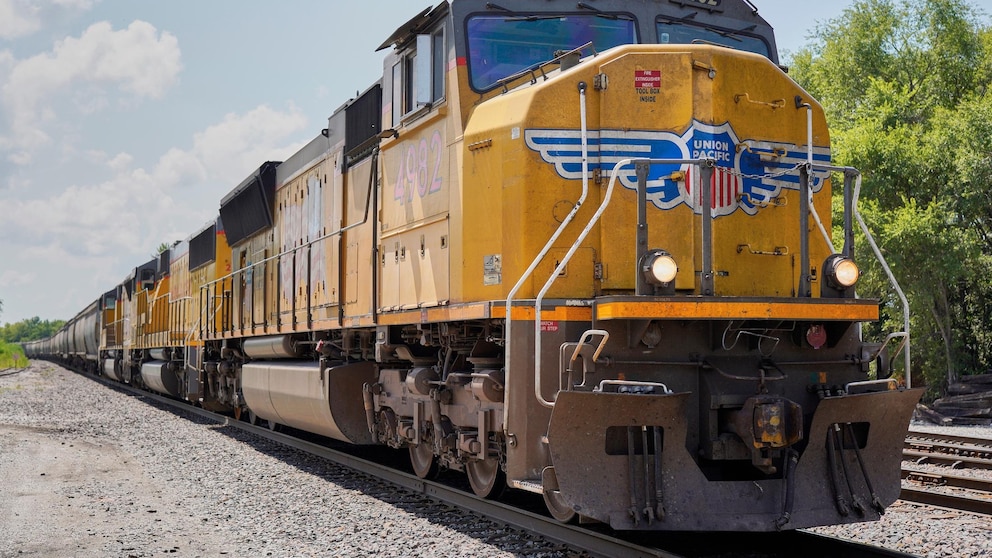
OMAHA, Neb. — Union Pacific's third-quarter profit fell 19% as the railroad hauled fewer shipments and costs remained high, but the average speed of its trains improved 5% as new CEO Jim Vena began to tweak the operations.
The Omaha, Nebraska, railroad earned $1.53 billion, or $2.51 per share, during the quarter, That's down from $1.9 billion, or $3.05 per share. But it tops the per-share earnings of $2.42 that Wall Street was expecting, according to a survey of analysts by FactSet Research.
The number of shipments Union Pacific delivered slipped 3% in the quarter, and while costs improved about 4% they remained elevated at $3.76 billion.
The railroad’s revenue slipped 10% to $5.9 billion because of the lower volume and the lag between when fuel prices increase and when Union Pacific’s fuel surcharge kicks in.
But the average speed of the railroad’s trains increased to 200 daily miles per car. Other productivity measures also improved during the quarter.
Train speed has continued to improve this month to about 210 daily miles per car today, but Vena said he wants to see that keep getting better to reach the 220s that Union Pacific used to deliver before the pandemic.
“Union Pacific has the capability and will be the most efficient railroad,” said Vena, who took the job in August.
One of Vena's initial moves has been to try to push decision-making lower down in the operation and eliminate layers of bureaucracy, so the railroad can react more quickly. More cuts are likely but major changes aren't expected because the railroad already overhauled its operations several years ago.
Vena said he still sees room to improve productivity but he won't be able to make the same kind of drastic changes he made when he was Union Pacific's chief operations officer in 2019 and 2020 because the railroad is already more efficient than it was back then.
“History will tell you that every time you think that there isn’t something that you can do better, you always find something, so there always is something that you can do better,” Vena said.
After more than a year of aggressive hiring to ensure Union Pacific has enough crews to operate its trains, Vena is now looking at trimming the workforce in places. The railroad will try to use attrition instead of layoffs to reduce the size of its workforce to get more efficient and match current volumes, Vena said. But Union Pacific will also keep working to improve the service it offers to make its deliveries more consistent and reliable to help make customers happy and attract new business.
Edward Jones analyst Jeff Windau said he'll be looking for improvement in all aspects of the railroad's operations as a result of Vena's focus on productivity and efficiency, but he expects the changes to be largely incremental.
Within his first two weeks on the job, Vena met with Union Pacific's two biggest unions and called the leader of a third one after getting a lukewarm reaction from them after his hiring. The railroad has reached a number of agreements over the past year to address some of workers' quality-of-life concerns by giving them paid sick time and more predictable schedules. Vena said he'll keep working to better the jobs he started out doing more than 40 years ago at the start of his career.
“I worked those jobs and I’ve worked the hours and everything else. So if we can do anything to work together to improve the life and still be productive and give people a better job, I’m all for that,” Vena said to The Associated Press.
The railroad said it still expects total volume may decline slightly this year because of the weak consumer demand. So shipments likely won't exceed the current forecast for flat industrial production.
Shares of Union Pacific gained more than 4% Thursday to trade for $214.55 in the afternoon.
Union Pacific is one of the nation's largest railroads and operates more than 30,000 miles of track in 23 western states. Safety has been a key concern for the industry this year ever since a Norfolk Southern train derailed in eastern Ohio in February. UP and the other major railroads are working to improve safety although they already have a record of being the safest way to transport cargo over land.
Sourse: abcnews.go.com






